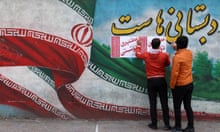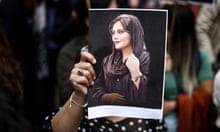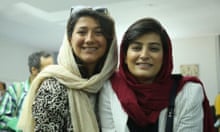Black-clad women in Iran’s Sistan-Baluchistan province have joined nationwide protests on Friday sparked by the death of Mahsa Amini, in what a rights group called a rare move in the staunchly conservative region.
Videos online showed dozens of women on the streets of the provincial capital, Zahedan, holding banners that declared “Woman, life, freedom” – one of the main slogans of the protest movement that erupted in mid-September.
“Whether with hijab or without it, onwards to revolution,” women dressed in body-covering chadors chanted in videos posted on Twitter and verified by AFP.
Protests led by women have swept Iran since Amini, a 22-year-old Iranian of Kurdish origin, died after her arrest in Tehran for an alleged breach of the Islamic republic’s dress code based on sharia law.
Security forces have killed at least 448 protesters, with the largest toll in Sistan-Baluchistan, on Iran’s south-eastern border with Afghanistan and Pakistan, according to Iran Human Rights, an Oslo-based non-governmental organisation.
“It is indeed rare,” the IHR director, Mahmood Amiry-Moghaddam, said of the protests by women in Zahedan, where men have been taking to the streets after Friday prayers for more than two months.
“The ongoing protests in Iran are the beginning of a revolution of dignity,” he said. “Women and minorities, who have for more than four decades been treated as second-class citizens, are empowered through these protests to come out to the streets and demand their fundamental human rights.”
He said Baluchi women were among the most oppressed in Iran and their protests on Friday were their most organised yet.
Scores of men also took to the streets on Friday, chanting “we don’t want a child-killing government”, footage posted online by activists showed.
In Taftan, a locality in Sistan-Baluchistan, security forces were seen opening fire with bird shot and teargas on male protesters, in a video published by IHR.
Mainly Sunni Muslim Sistan-Baluchistan is Iran’s poorest region, and many of its ethnic Baluch inhabitants feel discriminated against.
At least 128 people have been killed in Sistan-Baluchistan during the crackdown on protests, according to IHR, by far the biggest toll among deaths recorded in 26 of Iran’s 31 provinces.
More than 90 were killed on 30 September alone – a massacre that activists called “Black Friday”. Those protests were triggered by the alleged rape in custody of a 15-year-old girl by a police commander in the province’s port city of Chabahar.
Analysts say Baluchi people were inspired by the protests that flared over Amini’s death, which initially pressed for women’s rights but expanded over time to include other grievances.
“Iran’s Baluchi minority face entrenched discrimination that curtails their access to education, healthcare, employment, adequate housing and political office,” Amnesty International said on Tuesday. “The Baluchi minority have borne the brunt of the vicious crackdown by security forces during the uprising that has swept across Iran since September.”
Iran accuses the US, Britain and Israel of fomenting what it calls “riots”. The state news agency IRNA reported on Friday that authorities had summoned foreign diplomats 12 times since the protests erupted, “in reaction … to unprecedented pressure” imposed on the Islamic republic by their countries.
Iran has blamed protest-related violence in Kurdistan on separatists and has repeatedly launched deadly cross-border strikes on Kurdish groups exiled in Iraq. An Iranian general said this week that “more than 300 martyrs and people” have been killed in the unrest.
Thousands of Iranians and about 40 foreigners have been arrested during the demonstrations and more than 2,000 people have been charged, according to the country’s judicial authorities.










